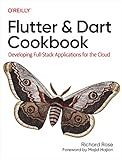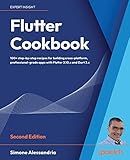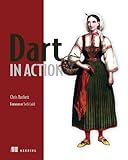Best Dart Programming Books to Buy in November 2025

Flutter Design Patterns and Best Practices: Build scalable, maintainable, and production-ready apps using effective architectural principles



Ultimate Flutter Handbook: Learn Cross-Platform App Development with Visually Stunning UIs and Real-World Projects (English Edition)



Flutter and Dart Cookbook: Developing Full-Stack Applications for the Cloud



Flutter Cookbook: 100+ step-by-step recipes for building cross-platform, professional-grade apps with Flutter 3.10.x and Dart 3.x, 2nd Edition



Flutter in 7 Days: Build user-friendly apps with widgets and navigation (English Edition)



Dart in Action



Dart Programming, In 8 Hours, For Beginners, Learn Coding Fast: Dart Programming Language, Crash Course Tutorial, Quick Start Guide & Exercises



Flutter for Beginners: An introductory guide to building cross-platform mobile applications with Flutter 2.5 and Dart



Flutter and Dart: Up and Running: Build native apps for both iOS and Android using a single codebase (English Edition)



Dart Programming, In 8 Hours, For Beginners, Learn Coding Fast: Dart Language Crash Course Textbook & Exercises (Cookbooks in 8 Hours 3)


Mixins in Dart provide a way to reuse code across multiple class hierarchies. They are similar to interfaces in other languages, but with the ability to provide a default implementation.
To use mixins in Dart, you need to define a mixin using the mixin keyword. For example:
mixin Logger { void log(String message) { print('[LOG] $message'); } }
You can then use the mixin in a class by using the with keyword. This allows the class to inherit the methods from the mixin:
class MyClass with Logger { void someMethod() { log('This is a log message'); // Call the log method from the Logger mixin } }
In this example, MyClass can now access the log method defined in the Logger mixin. The class "mixes in" the behavior of the Logger mixin.
You can also combine multiple mixins using commas:
class MyClass with Logger, OtherMixin { // class definition }
When using mixins, you should be cautious of potential naming conflicts. If multiple mixins define methods with the same name, the order of mixin application determines which method is used.
It's worth noting that a class can implement multiple interfaces while using mixins. Interfaces provide the contract, and mixins provide default implementations and additional behavior. However, unlike interfaces, mixins can also contain state and implement other methods.
Mixins are a powerful feature in Dart that allow for code reuse and composition. They can be handy when you need to share code across different class hierarchies and improve code modularity.
How to define a mixin in Dart?
In Dart, mixins can be defined using the mixin keyword.
Here's an example of defining a mixin in Dart:
mixin LoggerMixin { void log(String message) { print('Logging: $message'); } }
In this example, we have defined a mixin named LoggerMixin that implements a log method. The log method simply prints the given message to the console.
To use this mixin in a class, you can simply include it using the with keyword:
class MyClass with LoggerMixin { void doSomething() { log('Doing something...'); } }
The with keyword is used to include the functionality of the mixin in the class. In this case, the MyClass class will have access to the log method defined in the LoggerMixin mixin.
Note that mixins can also include fields, properties, and other methods just like regular classes. However, they cannot be instantiated on their own. They are only meant to be used as a way to share common functionality across multiple classes.
What are some common pitfalls to avoid when using mixins in Dart?
Some common pitfalls to avoid when using mixins in Dart are:
- Order of mixin application: The order in which mixins are applied can affect the behavior of the class. If the order is not correct, it can lead to unexpected results. Make sure to apply mixins in the correct order to ensure the desired behavior.
- Name conflicts: Mixins can introduce naming conflicts if two or more mixins have methods or properties with the same name. To avoid this, it's important to explicitly specify the override keyword when necessary or use unique names to prevent conflicts.
- Dependency management: If a mixin relies on certain properties or methods from the class it's mixed into, ensure that those dependencies are satisfied. Failure to do so can lead to runtime errors or unexpected behavior.
- Overuse of mixins: While mixins can be powerful, they should be used judiciously. Overusing mixins or applying too many can make the class hierarchy complex and harder to understand, maintain, and debug. Try to keep mixins focused on a specific aspect of functionality.
- Incompatibility with inheritance: When mixing in multiple classes with inheritance, be aware that there can be conflicts and inconsistencies. It's important to understand the interactions between mixins and inheritance to avoid unintended consequences.
- Versioning and compatibility: Mixins can introduce breaking changes when new versions of the Dart language are released. Be cautious when updating your codebase to a new Dart version that might introduce breaking changes that impact mixins.
- Mixing in unstable or unreliable code: When using mixins from external packages or libraries, be cautious about the stability and reliability of the code. Mixing in unstable or poorly-maintained mixins can introduce bugs or compatibility issues.
Overall, while mixins can be a powerful tool for code reuse in Dart, it's important to use them carefully, keeping in mind potential pitfalls and their impact on code readability and maintainability.
What is a mixin in Dart programming language?
A mixin in Dart is a way to reuse code in multiple class hierarchies without using inheritance. It allows a class to include the methods and properties of another class without inheriting from it.
In Dart, a mixin is defined using the mixin keyword followed by the mixin name and the implementation of the mixin. Mixins can have constructors, member variables, and methods just like regular classes, but they cannot be instantiated directly and cannot inherit from other classes.
To use a mixin in a class, the with keyword is used followed by the name of the mixin. This allows the class to include the methods and properties of the mixin. The class can still inherit from another class while using a mixin.
Here's an example of a mixin in Dart:
mixin LoggerMixin { void log(String message) { print('Logging: $message'); } }
class MyClass extends SomeOtherClass with LoggerMixin { // ... }
In the above example, the LoggerMixin provides the log method, which can be used by instances of MyClass. The MyClass can also inherit from SomeOtherClass at the same time, allowing for code reuse from both the superclass and the mixin.
How to mix in a mixin conditionally based on runtime conditions in Dart?
To mix in a mixin conditionally based on runtime conditions in Dart, you can use the if statement in the with clause. Here's an example:
mixin MyMixin { void mixinMethod() { print('Mixin method called'); } }
class MyClass extends Object with MyMixin { // ... }
void main() { bool condition = true; // Your runtime condition
MyClass myInstance = MyClass();
if (condition) { myInstance = myInstance..mixinMethod(); }
// ... }
In this example, we have a mixin called MyMixin with a method called mixinMethod. We also have a class called MyClass that mixes in MyMixin.
Inside the main function, you can set a runtime condition using a boolean variable condition. If the condition is true, you can call the mixin method mixinMethod on an instance of MyClass.
By chaining the method call using the cascade notation (..), we ensure that the method is only called when the condition is true. If the condition is false, the method is not called, and the instance of MyClass remains unaffected.
How to use mixins for implementing utility functions in Dart?
To use mixins for implementing utility functions in Dart, you can follow these steps:
- Define the mixin class with the utility functions you want to add to other classes. For example:
mixin StringUtils { String capitalize(String text) { return text.substring(0, 1).toUpperCase() + text.substring(1); }
String reverse(String text) { return text.split('').reversed.join(); } }
- Create a class that will use the mixin. For this, use the with keyword and specify the mixin class. For example:
class Person with StringUtils { String name;
Person(this.name);
String getCapitalizedName() { return capitalize(name); } }
- Now, you can create an object of the Person class and call the utility functions from the mixin class. For example:
void main() { var person = Person('john doe'); print(person.getCapitalizedName()); // Output: John doe print(person.reverse('hello')); // Output: olleh }
In the above code, the Person class is using the StringUtils mixin. This allows the Person object to call the capitalize function from the StringUtils mixin, and the utility function reverse as well.
Mixins provide a way to reuse code across multiple classes without inheritance, allowing for more flexible code organization and composition.
